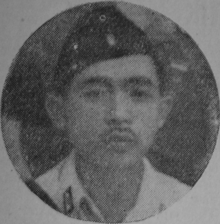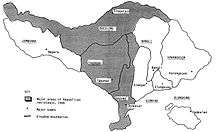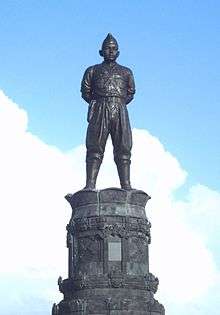I Gusti Ngurah Rai
| I Gusti Ngurah Rai | |
|---|---|
 | |
| Birth name | I Gusti Ngurah Rai |
| Born |
30 January 1917 Badung Regency, Bali, Dutch East Indies |
| Died |
20 November 1946 (aged 29) Marga, Bali, Indonesia |
| Allegiance | Indonesia |
| Service/branch | Army |
| Rank | Lieutenant Colonel |
| Battles/wars | Battle of Margarana |
| Awards | National Hero of Indonesia |
Lieutenant Colonel I Gusti Ngurah Rai (30 January 1917 – 20 November 1946) is an Indonesian National Hero who commanded Indonesian forces in Bali against the Dutch during the Indonesian War of Independence. He was killed in the Battle of Margarana.[1][2]
Early life
Ngurah Rai was born in Carangsari, Badung Regency, Bali on 30 January 1917. He studied at a Dutch elementary school, then went to high school in Malang, East Java. He then received Dutch military training at the Military Cadet School in Gianyar, Bali and Magelang, Central Java. After graduating, he joined the Dutch-sponsored military as a second lieutenant in Bali.[2][3]
Military career


After the Indonesian Declaration of Independence he established the People's Security Army, the forerunner of the military of Indonesia, for the Lesser Sunda Islands. He then left for the republican capital, Yogyakarta to receive orders before returning to Bali to oppose the approximately 2,000 Dutch troops who had landed on 2 and 3 March 1946.[3]

Ngurah Rai found that the republican forces were divided and he worked hard to reunite them. He then organized the first attack against the Dutch forces headquarters at Tabanan. The Dutch then attempted to locate Nguraha Rai's base and offered negotiations, which he refused.
On 20 November 1946, the Dutch launched a large attack on Marga with the assistance of troops from Lombok and supported by aircraft. Lt. Col Ngurah Rai ordered a Puputan, or fight to the death. He died along with all of his troops. The battle is now known as the Battle of Margarana.[2]
Burial and national hero status
Ngurah Rai was buried in Marga. On 9 August 1975, he was made a national hero via Presidential Decision No. 063/TK/TH 1975.[2] Ngurah Rai International Airport in Bali is named for him and he appears on the IDR50,000 note.
Notes
References
| Wikimedia Commons has media related to I Gusti Ngurah Rai. |
- Mutiara Sumber Widya (publisher)(1999) Album Pahlawan Bangsa (Album of National Heroes), Jakarta (Indonesian)
- Pringle, Robert (2004). Bali: Indonesia's Hindu Realm; A short history of. Short History of Asia Series. Allen & Unwin. ISBN 1-86508-863-3.
- Sudarmanto, Y.B. (1996) Jejak-Jejak Pahlawan dari Sultan Agung hingga Syekh Yusuf (The Footsteps of Heroes from Sultan Agung to Syekh Yusuf), Penerbit Grasindo, Jakarta ISBN 979-553-111-5 (Indonesian)